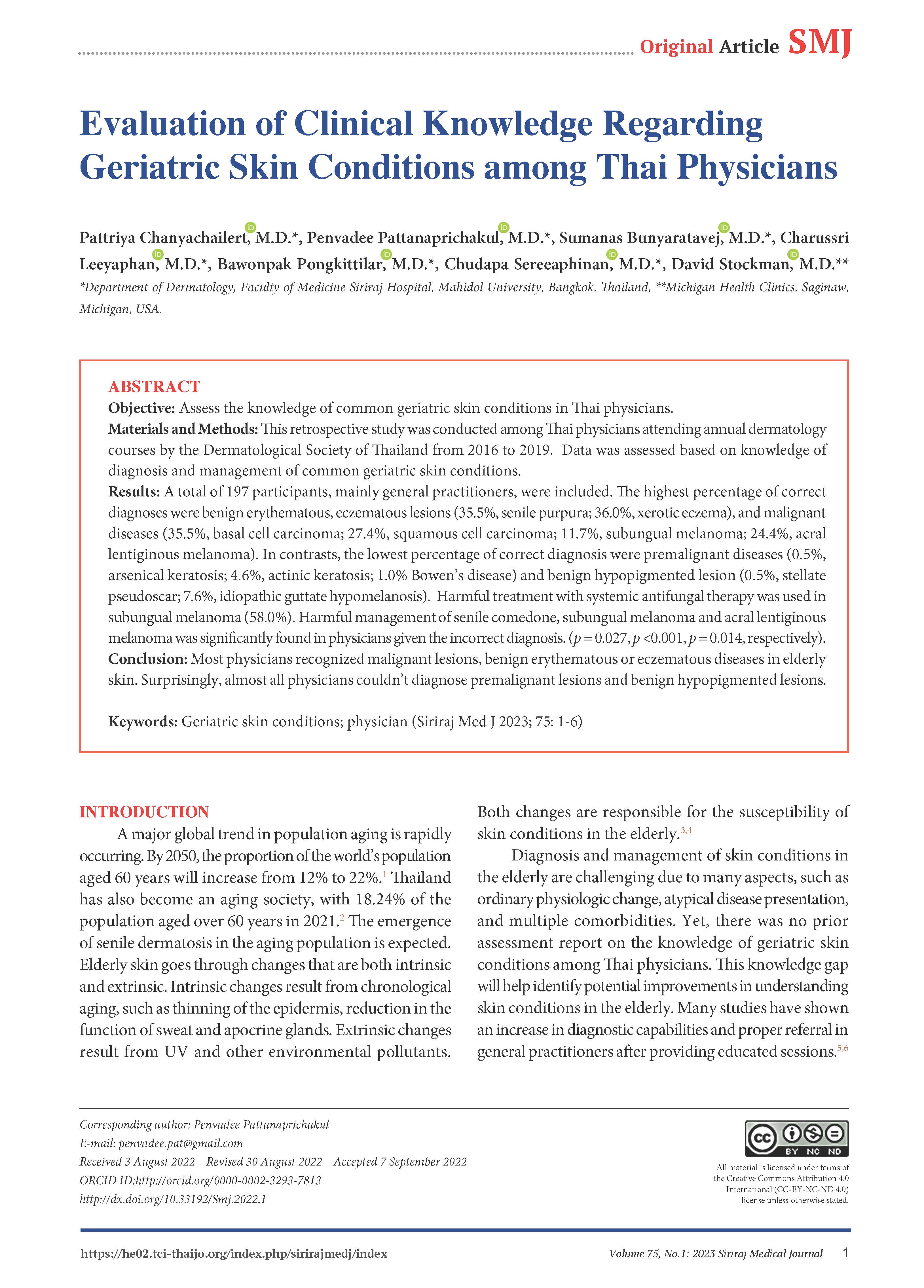Evaluation of Clinical Knowledge Regarding Geriatric Skin Conditions among Thai Physicians
DOI:
https://doi.org/10.33192/smj.v75i1.260522Keywords:
Geriatric skin conditions, physicianAbstract
Objective: Assess the knowledge of common geriatric skin conditions in Thai physicians.
Materials and Methods: This retrospective study was conducted among Thai physicians attending annual dermatology courses by the Dermatological Society of Thailand from 2016 to 2019. Data was assessed based on knowledge of diagnosis and management of common geriatric skin conditions.
Results: A total of 197 participants, mainly general practitioners, were included. The highest percentage of correct diagnoses were benign erythematous, eczematous lesions (35.5%, senile purpura; 36.0%, xerotic eczema), and malignant diseases (35.5%, basal cell carcinoma; 27.4%, squamous cell carcinoma; 11.7%, subungual melanoma; 24.4%, acral lentiginous melanoma). In contrasts, the lowest percentage of correct diagnosis were premalignant diseases (0.5%, arsenical keratosis; 4.6%, actinic keratosis; 1.0% Bowen’s disease) and benign hypopigmented lesion (0.5%, stellate pseudoscar; 7.6%, idiopathic guttate hypomelanosis). Harmful treatment with systemic antifungal therapy was used in subungual melanoma (58.0%). Harmful management of senile comedone, subungual melanoma and acral lentiginous melanoma was significantly found in physicians given the incorrect diagnosis. (p = 0.027, p <0.001, p = 0.014, respectively).
Conclusion: Most physicians recognized malignant lesions, benign erythematous or eczematous diseases in elderly skin. Surprisingly, almost all physicians couldn’t diagnose premalignant lesions and benign hypopigmented lesions.
References
World Health Organization. Aging and Health [Internet]. Switzerland: World Health Organization; 2021 Oct [cited 2022 Mar 31]. Available from: https://www.who.int/newsroom/fact-sheets/detail/ageing-and-health.
National Statistic Office. Demography population and housing branch [Internet]. Thailand: National Statistic Office; 2021 [cited 2022 Mar 31]. Available from: https://statbbi.nso.go.th/staticreport/page/sector/en/01.aspx.
Jafferany M, Huynh TV, Silverman MA, Zaidi Z. Geriatric dermatoses: a clinical review of skin diseases in an aging population. Int J Dermatol. 2012;51(5):509-22.
Zalaudek I, Lallas A, Longo C, Moscarella E, Tiodorovic-Zivkovic D, Ricci C, et al. Problematic lesions in the elderly. Dermatol Clin. 2013;31(4):549-64, vii-viii.
Beecher SM, Keogh C, Healy C. Dedicated general practitioner education sessions can improve diagnostic capabilities and may lesions. Ir J Med Sci. 2018;187(4):959-63.
Basarab T, Munn SE, Jones RR. Diagnostic accuracy and appropriateness of general practitioner referrals to a dermatology out-patient clinic. Br J Dermatol. 1996;135(1):70-3.
Paine SL, Cockburn J, Noy SM, Marks R. Early detection of skin cancer. Knowledge, perceptions and practices of general practitioners in Victoria. Med J Aust. 1994;161(3):188-9, 92-5.
Halpern AC, Hanson LJ. Awareness of, knowledge of and attitudes to nonmelanoma skin cancer (NMSC) and actinic keratosis (AK) among physicians. Int J Dermatol. 2004;43(9):638-42.
Ruben BS. Pigmented lesions of the nail unit: clinical and histopathologic features. Semin Cutan Med Surg. 2010;29(3):148-58.
Cust AE. Prognostic features for acral lentiginous melanoma. Br J Dermatol. 2018;178(2):311-2.
da Silva DLF, Toribio JM, Cintra ML, Magalhaes RF, Padoveze EH. Subungual Acral Lentiginous Melanoma of the Fifth Toe. Skin Appendage Disord. 2019;5(6):401-4.

Published
How to Cite
Issue
Section
License

This work is licensed under a Creative Commons Attribution-NonCommercial-NoDerivatives 4.0 International License.
Authors who publish with this journal agree to the following conditions:
Copyright Transfer
In submitting a manuscript, the authors acknowledge that the work will become the copyrighted property of Siriraj Medical Journal upon publication.
License
Articles are licensed under a Creative Commons Attribution-NonCommercial-NoDerivatives 4.0 International License (CC BY-NC-ND 4.0). This license allows for the sharing of the work for non-commercial purposes with proper attribution to the authors and the journal. However, it does not permit modifications or the creation of derivative works.
Sharing and Access
Authors are encouraged to share their article on their personal or institutional websites and through other non-commercial platforms. Doing so can increase readership and citations.














